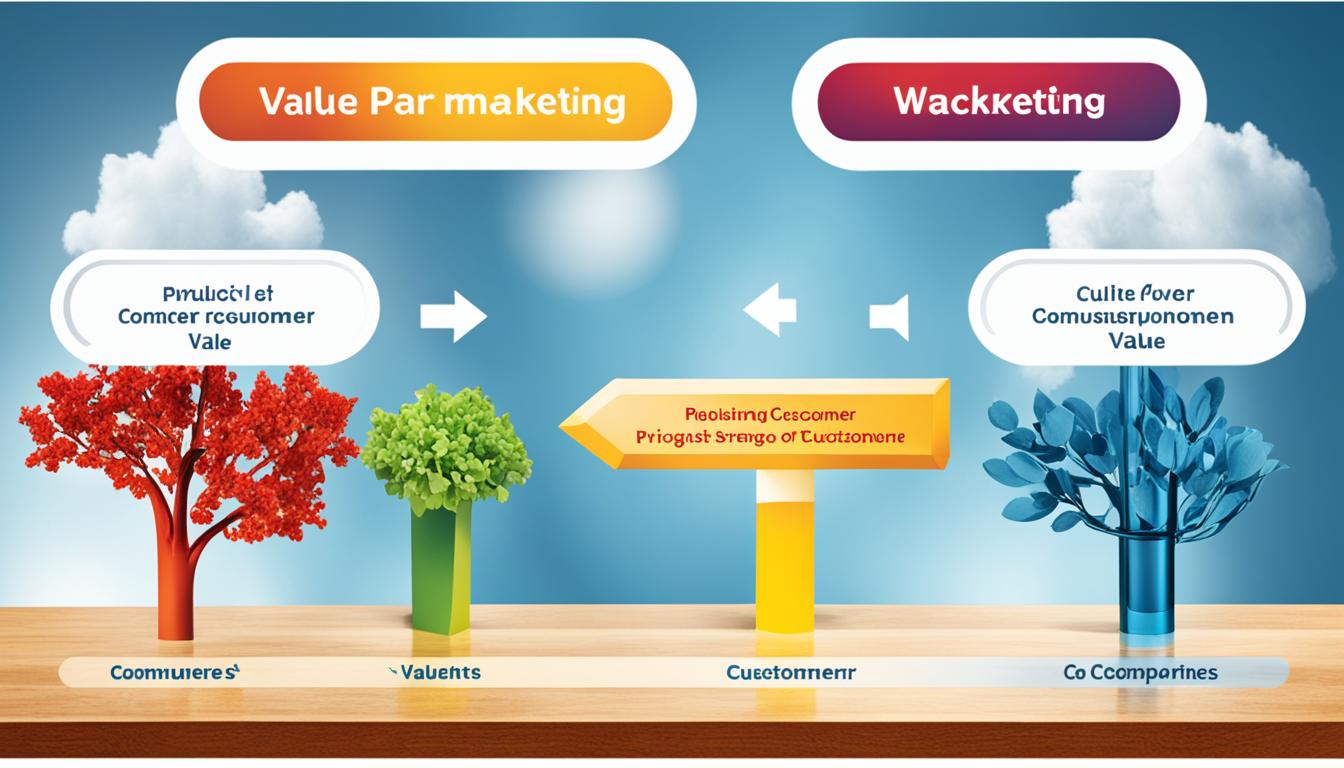VALS is a marketing framework that categorizes US adults into eight distinct types based on their values, attitudes, and lifestyles. It provides valuable insights into consumer behavior, allowing businesses to tailor their marketing strategies to target specific consumer segments effectively.
Key Takeaways:
- VALS is a marketing framework that categorizes US adults into eight distinct types based on their values, attitudes, and lifestyles.
- It provides valuable insights into consumer behavior, allowing businesses to tailor their marketing strategies effectively.
- Understanding VALS can help businesses connect with their target audience on a deeper level.
- VALS helps identify shared values and motivations among consumer segments.
- Applying the VALS framework can enhance brand loyalty and improve marketing ROI.
Understanding the VALS Framework
The VALS framework is a powerful tool in analyzing consumer behavior by delving into the deeper aspects of values, motivations, and lifestyles. Unlike traditional demographic analysis, the VALS framework categorizes individuals into distinct consumer groups based on shared values and motivations. This framework provides businesses with a comprehensive understanding of consumer behavior and enables them to align their marketing strategies with the core values and beliefs of their target audience.
The VALS framework identifies the intrinsic factors that drive consumer choices, going beyond surface-level demographics. By focusing on values and attitudes, businesses can gain valuable insights into the motivations and preferences of different consumer segments.
The Power of Values and Motivations
Values play a crucial role in shaping consumer behavior. They reflect an individual’s beliefs, ethical standards, and principles. Understanding these values helps businesses identify key drivers behind consumer choices. Motivations, on the other hand, drive individuals to act on their values and make purchasing decisions that align with their beliefs.
By categorizing consumers based on shared values and motivations, the VALS framework creates distinct consumer groups. These groups enable businesses to tailor their marketing strategies to appeal to specific target audiences, enhancing the effectiveness of their campaigns.
Insights into Lifestyles and Behaviors
Lifestyles are an integral part of the VALS framework. They take into account the broader aspects of consumer behavior, including activities, interests, and opinions. By analyzing these lifestyle factors, businesses can gain deeper insights into their target audience and develop strategies that resonate with their preferences and behaviors.
The VALS framework offers a comprehensive view of consumer behavior by considering the interactions between values, motivations, and lifestyles. It allows businesses to identify the underlying factors that drive purchasing decisions, enabling them to create targeted marketing campaigns that connect with consumers on a personal level.
Primary Motivations in the VALS Model
The VALS model identifies three primary motivations that play a critical role in influencing consumer behavior: ideals, achievement, and self-expression. Understanding these motivations is essential for businesses to effectively communicate with their target audience and create strategic marketing campaigns.
Ideals
Consumers motivated by ideals prioritize knowledge and principles. They are driven by their desire to make informed choices and align themselves with brands that share their values. These individuals value ethical practices, sustainability, and social responsibility when making purchasing decisions. For marketers, appealing to the ideals of these consumers requires communicating a brand’s commitment to these values and illustrating how their products or services contribute to positive change.
Achievement
Consumers driven by achievement seek products and experiences that demonstrate success to their peers. They seek validation and recognition through their purchases. These individuals are motivated by prestige, status, and the desire to be seen as successful. Marketers targeting this segment need to emphasize how their products or services elevate their customers’ social status, enhance their image, or provide exclusive benefits. By appealing to their desire for recognition, businesses can effectively engage these consumers and drive their purchasing decisions.
Self-Expression
The self-expression group desires social or physical activity, variety, and risk. They seek products and experiences that allow them to express their individuality and uniqueness. These individuals are motivated by creativity, independence, and the need for personal freedom. Marketers targeting this segment can appeal to their desire for self-expression by presenting opportunities for customization, co-creation, and personalization. Engaging these consumers through interactive and immersive experiences that allow them to showcase their identity and personal style is essential for capturing their attention and driving their loyalty.
By understanding these primary motivations—ideals, achievement, and self-expression—businesses can craft targeted marketing messages that align with their target audience’s core values and desires. Incorporating these motivations into strategic marketing campaigns allows businesses to establish meaningful connections with their customers and drive long-term brand loyalty.
Resources in the VALS Model
The VALS model takes into account various factors when categorizing individuals, recognizing that a person’s resources extend beyond traditional demographic characteristics like age, income, and education. In addition to these factors, psychological traits play a critical role in determining an individual’s resources and influencing their consumer choices.
Psychological traits such as energy, self-confidence, intellectualism, and impulsiveness can significantly impact a person’s resources. For example, someone who possesses high energy levels and self-confidence may have the resources to pursue their primary motivations more effectively. On the other hand, someone with lower energy levels and self-confidence may face constraints in expressing their primary motivations.
Understanding an individual’s resources is essential because it helps businesses tailor their marketing strategies to resonate with specific consumer segments. By recognizing the psychological traits that shape a person’s resources, businesses can develop targeted approaches to address the unique needs and preferences of different consumer groups.
Here is a table summarizing the different psychological traits that influence an individual’s resources:
| Psychological Traits | Impact on Resources |
|---|---|
| Energy | High energy levels provide individuals with the resources to engage in various activities and pursue their motivations actively. |
| Self-confidence | Individuals with high self-confidence are more likely to have the resources to express their motivations and make consumer choices confidently. |
| Intellectualism | Intellectualism enhances an individual’s resources by allowing them to seek knowledge, make informed decisions, and prioritize value-based choices. |
| Impulsiveness | Impulsive individuals may have fluctuating resources, as their consumer choices are influenced by immediate desires and instincts. |
How the VALS Model Works
The VALS model operates on two dimensions: motivation and resources. Understanding these dimensions is crucial in gaining insights into consumer behavior and developing effective marketing strategies.
Motivation
Motivation in the VALS model is categorized into three primary categories: ideals, achievement, and self-expression.
- Ideals: Consumers motivated by ideals prioritize knowledge, principles, and personal growth.
- Achievement: Consumers driven by achievement seek products that demonstrate success and recognition.
- Self-expression: Consumers motivated by self-expression desire social or physical activity, variety, and risk-taking.
Resources
Resources refer to the economic, psychological, and physical means individuals have to pursue their motivations within the VALS framework.
These resources can enhance or constrain a person’s expression of their primary motivation. Factors such as income, education, age, and psychological traits like self-confidence and intellectualism play a significant role in determining an individual’s resources.
By understanding the motivation and resource dimensions of the VALS model, businesses can gain a deeper understanding of consumer behavior. This understanding allows businesses to develop targeted marketing strategies that resonate with specific consumer segments.
| VALS Model Dimensions | Motivation | Examples |
|---|---|---|
| Motivation | Ideals | Knowledge, principles, personal growth |
| Achievement | Success, recognition | |
| Self-expression | Social or physical activity, variety, risk-taking | |
| Resources | Demographic (e.g., age, income, education) | Income, education level, age |
| Psychological traits | Self-confidence, intellectualism, impulsiveness | |
| Economic | Financial status, access to disposable income | |
| Physical | Health, mobility, physical capabilities |
Applications of the VALS Model
The VALS model offers valuable insights that businesses can leverage to optimize their marketing strategies. By understanding the target audience’s values, attitudes, and lifestyles, businesses can create accurate customer profiles and personas, enabling them to tailor their advertising strategies to connect on a deeper level. Additionally, businesses can strategically align product placements with the values and motivations of the target audience for maximum impact. Furthermore, creating relevant content that resonates with specific VALS segments enhances engagement and relevance, resulting in more effective communication and increased brand loyalty.
To demonstrate the wide-ranging applications of the VALS model, here are a few key areas where it can be effectively applied:
- Target Audience: Understanding the target audience is essential for effective marketing. The VALS model allows businesses to gain in-depth insights into their specific market segments, enabling them to identify and target consumers who align with their brand values and messaging.
- Advertising Strategies: By leveraging the VALS model’s insights, businesses can tailor their advertising strategies to effectively reach and engage with consumers based on their values, attitudes, and lifestyles. This enables businesses to create campaigns that resonate with consumers on a personal level, resulting in increased brand relevance and customer loyalty.
- Product Placement: Strategic product placement can significantly impact consumer behavior. By aligning product placements with the values and motivations of specific VALS segments, businesses can create meaningful associations between their products and the target audience’s aspirations and desires.
- Content Creation: Creating relevant and compelling content is crucial for capturing and maintaining consumer attention. By understanding the values and motivations of specific VALS segments, businesses can develop content that speaks directly to their target audience, increasing engagement and driving desired actions.
| Applications of the VALS Model | Description |
|---|---|
| Target Audience | Gain insights into consumer segments and target customers who align with brand values. |
| Advertising Strategies | Tailor marketing campaigns to resonate with specific VALS segments and enhance brand relevance. |
| Product Placement | Strategically align product placements with the values and motivations of the target audience. |
| Content Creation | Create relevant and engaging content that resonates with specific VALS segments. |
Real-World Examples of the VALS Model
Real-world businesses have successfully utilized the VALS model to connect with specific consumer segments and enhance brand loyalty. Let’s explore how three prominent brands, Patagonia, Apple, and Dove, have effectively resonated with consumers using the VALS model.
Patagonia: Targeting Consumers Motivated by Ideals
Patagonia, an outdoor apparel company, has positioned itself as a leader in sustainability and ethical practices, effectively targeting consumers motivated by ideals. By emphasizing their commitment to environmental consciousness, Patagonia has built a loyal customer base of like-minded individuals who prioritize responsible and eco-friendly consumption. Their messaging reflects their dedication to preserving natural resources and encourages consumers to make mindful purchases.
Apple: Strategic Targeting of Consumers Driven by Achievement
Apple strategically targets consumers who are driven by achievement, positioning their products as symbols of success and accomplishment. Through their sleek and innovative design, Apple products convey a sense of superiority and exclusivity. By aligning their brand with luxury and high-quality technology, Apple appeals to consumers who seek recognition and status through their possessions. This marketing approach has contributed to Apple’s strong brand image and immense popularity among achievement-oriented individuals.
Dove: Resonating with Consumers Motivated by Self-Expression
Dove, a renowned personal care brand, effectively resonates with consumers motivated by self-expression by promoting inclusivity and embracing uniqueness. Dove’s campaigns focus on celebrating and empowering individuals of all backgrounds, body types, and ages. By challenging stereotypes and promoting diversity, Dove has successfully connected with consumers who value self-expression and authenticity. Their commitment to fostering positive body image and self-love has garnered widespread praise and loyalty.
| Brand | Motivation | VALS Segment |
|---|---|---|
| Patagonia | Ideals | To achieve a sustainable and ethical lifestyle |
| Apple | Achievement | To demonstrate success and accomplishment through their products |
| Dove | Self-Expression | To promote inclusivity, diversity, and self-acceptance |
These real-world examples demonstrate how the VALS model can guide businesses in understanding their target audience’s motivations and values, thus enabling them to create marketing strategies that effectively resonate with specific consumer segments.
Challenges and Considerations of the VALS Model
While the VALS model is a powerful tool for understanding consumer behavior and shaping marketing strategies, businesses may encounter several challenges during its implementation. These challenges include complexity and data collection, overlapping segments, evolving consumer behavior, accessibility, and privacy concerns.
Complexity and Data Collection
The VALS model involves a complex analysis that requires businesses to gather extensive data about their target audience. This process can be time-consuming and resource-intensive, requiring careful consideration of data collection methods and techniques.
Overlapping Segments
One challenge that businesses may face when utilizing the VALS model is the presence of overlapping segments. Due to the diversity and complexity of consumers’ values, attitudes, and lifestyles, some individuals may fall into multiple segments. This overlap can make it difficult to accurately target and tailor marketing strategies to specific consumer groups.
Evolving Consumer Behavior
Another consideration when using the VALS model is the ever-changing nature of consumer behavior. Consumers’ values, attitudes, and lifestyles are not static and can evolve over time. Businesses must stay up-to-date with current trends and regularly reassess their target audience to ensure their marketing strategies remain effective.
Accessibility
Ensuring accessibility is essential when implementing the VALS model. While the framework provides valuable insights, it should be accessible to all members of the marketing team. Businesses should invest in training and educational resources to ensure that everyone involved understands the model’s concepts and can effectively apply them to marketing strategies.
Privacy Concerns
The collection and utilization of consumer data raise privacy concerns. Businesses must be transparent with customers about their data collection practices and ensure compliance with privacy regulations. Respecting consumer privacy is crucial for maintaining trust and building strong customer relationships.
Despite these challenges, businesses can overcome them by starting with broad research, recognizing shared values among segments, adapting to changing consumer behavior, ensuring inclusivity, educating marketing teams, and addressing privacy concerns. By actively addressing these considerations, businesses can harness the power of the VALS model to drive effective marketing campaigns and better connect with their target audience.
History and Description of VALS
The VALS framework, short for Values, Attitudes, and Lifestyles, was developed in 1978 by Arnold Mitchell and his colleagues at SRI International. Their work drew on the research of renowned sociologist David Riesman and psychologist Abraham Maslow. VALS revolutionized consumer behavior analysis by categorizing individuals into distinct lifestyle types based on attitudinal and demographic questions.
The framework considers two crucial dimensions: resources and primary motivation, to provide a comprehensive understanding of consumer behavior. By analyzing these dimensions, businesses gain valuable insights into the values, attitudes, and lifestyles that drive consumer choices.
Dimensions of VALS
The VALS framework comprises two key dimensions:
- Resources: This dimension extends beyond traditional demographic factors such as age, income, and education. It also takes into account psychological traits, including energy, self-confidence, intellectualism, and impulsiveness. By understanding a person’s resources, businesses can gauge their ability to pursue their primary motivations effectively.
- Primary Motivation: VALS identifies three primary motivations that shape consumer behavior:
| Primary Motivation | Description |
|---|---|
| Ideals | Consumers motivated by ideals prioritize knowledge and principles. They seek products and services that align with their personal values and ethical beliefs. |
| Achievement | Consumers driven by achievement are highly concerned with success and recognition. They prefer products that demonstrate their accomplishments and signal status to others. |
| Self-Expression | Consumers motivated by self-expression desire social or physical activity, variety, and risk. They seek products that enable them to express their uniqueness and individuality. |
By considering both resources and primary motivation, the VALS model provides a nuanced understanding of consumer behavior while highlighting the interplay between individual characteristics and external factors. This framework allows businesses to tailor their marketing strategies to engage and resonate with their target audience at a deeper level.
As shown in the VALS framework above, the relationship between resources and primary motivation helps identify the different lifestyle types and the behaviors associated with each segment. By recognizing these lifestyle types, businesses can tailor their marketing messages, develop relevant products, and create impactful marketing campaigns that appeal to the specific needs, values, and motivations of their target audience.
Criticisms of the VALS Model
The VALS model, while widely used and respected in the field of market research, has not been without its criticisms. One of the main criticisms is that psychographics, which the VALS model heavily relies on, may not be strong predictors of consumer purchases. Some argue that a person’s values, attitudes, and lifestyles may not necessarily translate into their actual buying behavior.
Furthermore, the VALS model has been criticized for its cultural specificity, making it less applicable in international markets. The model was developed based on the values and lifestyles of US consumers, which may not align with those of consumers in other countries. This cultural bias limits the model’s effectiveness and applicability on a global scale.
It is important for businesses to consider these criticisms and evaluate the limitations of the VALS model when implementing it in their marketing strategies. While the model provides valuable insights into consumer behavior, it should be used alongside other research methods to gain a comprehensive understanding of the target audience.
VALS Segments of US Adults
The VALS framework categorizes US adults into segments based on their values and motivations. These segments include:
- Innovators: These individuals are highly educated with high incomes and are early adopters of new products and ideas. They are driven by the desire for social esteem and have a high level of self-expression.
- Thinkers: Thinkers are motivated by knowledge and are practical, reflective, and well-informed individuals. They prefer durability and functionality over luxury and are conscious of the environment.
- Believers: Believers are conservative and traditional individuals who value practicality and trust. They are committed to their faith, family, and community and prefer established brands and familiar products.
- Achievers: Achievers are successful and career-oriented individuals who value the opinions of others. They prefer premium products and status symbols that showcase their success and achievement.
- Strivers: Strivers are ambitious and image-conscious individuals who strive for social approval and personal success. They are attracted to popular brands and products that reflect their aspirations.
- Experiencers: Experiencers are young, enthusiastic individuals who are impulsive buyers and enjoy variety and excitement. They prioritize having fun and seek new experiences, often opting for trendsetting products.
- Makers: Makers are practical and self-sufficient individuals who enjoy working with their hands. They prefer DIY projects and products that allow them to create and express their individuality.
- Survivors: Survivors are individuals on the lower end of the socioeconomic scale. They focus on meeting their basic needs and are wary of change. They prefer familiar and affordable products.
Each VALS segment has distinct characteristics and consumer behaviors that businesses can target based on their marketing goals and strategies. Understanding these segments allows businesses to tailor their messaging and offerings to resonate with the specific values and motivations of each group.
Overview of VALS Segments
| Segment | Characteristics | Consumer Behavior |
|---|---|---|
| Innovators | Highly educated, high incomes, early adopters | Seek new products and ideas, high self-expression |
| Thinkers | Reflective, well-informed, environmentally conscious | Practical, durability over luxury, value knowledge |
| Believers | Traditional, conservative, value practicality and trust | Prefer established brands, loyal, faith-oriented |
| Achievers | Successful, career-oriented, status-conscious | Value others’ opinions, prefer premium products |
| Strivers | Ambitious, image-conscious, seek social approval | Aspire for success, attracted to popular brands |
| Experiencers | Young, enthusiastic, impulsive buyers | Enjoy variety and excitement, trendsetters |
| Makers | Practical, self-sufficient, enjoy DIY projects | Prefer hands-on creations, express individuality |
| Survivors | Lower socioeconomic scale, focused on basic needs | Prefer familiar, affordable products, wary of change |
Conclusion
The VALS framework plays a crucial role in understanding consumer behavior and formulating effective marketing strategies. By delving into individuals’ values, attitudes, and lifestyles, businesses can establish a deeper connection with their target audience. The insights derived from the VALS model provide invaluable guidance in creating relevant content, devising impactful advertising strategies, and optimizing product placements.
Utilizing the VALS model allows businesses to decode the nuances of consumer behavior, enabling them to tailor their marketing efforts to meet their audience’s needs. This framework offers a comprehensive understanding of primary motivations, resources, and the interplay between different consumer segments. Armed with this knowledge, businesses can design compelling marketing campaigns that resonate with their target market.
To achieve success in today’s competitive landscape, it is vital for businesses to recognize the significance of the VALS framework. By leveraging consumer behavior insights derived from this model, companies can refine their marketing strategies, enhance customer engagement, and foster long-term brand loyalty. The VALS framework empowers businesses to make informed decisions and stay ahead in an ever-evolving marketplace.
FAQ
What is the VALS framework in marketing, and why is it important?
The VALS framework is a marketing tool that categorizes US adults into distinct segments based on their values, attitudes, and lifestyles. It helps businesses gain insights into consumer behavior and tailor their marketing strategies accordingly.
How does the VALS framework analyze consumer behavior?
The VALS framework goes beyond traditional demographic analysis and focuses on intrinsic values and lifestyles that drive consumer choices. It categorizes individuals into consumer groups based on shared values and motivations.
What are the primary motivations in the VALS model?
The VALS model identifies three primary motivations that influence consumer behavior: ideals, achievement, and self-expression.
How do resources play a role in the VALS model?
Resources extend beyond traditional demographics and include psychological traits that influence consumer behavior. These resources can enhance or constrain an individual’s expression of their primary motivation.
How does the VALS model work?
The VALS model operates on two dimensions: motivation and resources. Motivation encompasses three primary categories, while resources refer to the means individuals have to pursue their motivations.
How can businesses apply the VALS model in their marketing strategies?
Businesses can use the VALS model to create accurate customer profiles, tailor advertising strategies, strategically place products, and create relevant content that resonates with specific consumer segments.
Can you provide real-world examples of the VALS model in action?
Yes, businesses like Patagonia, Apple, and Dove effectively target specific VALS segments by aligning their marketing strategies with consumer values and motivations.
What are the challenges and considerations when using the VALS model?
Some challenges businesses may face include complexity in data collection, overlapping segments, evolving consumer behavior, accessibility, and privacy concerns. However, these can be overcome by proper research, recognizing shared values, and addressing privacy concerns.
Who developed the VALS model, and what is its history?
The VALS model was developed in 1978 by Arnold Mitchell and his colleagues at SRI International. It draws inspiration from sociologist David Riesman and psychologist Abraham Maslow.
What criticisms exist regarding the VALS model?
Critics argue that psychographics are weak predictors of consumer purchases, and the VALS model may be too culturally specific for international use.
What are the different VALS segments of US adults?
The VALS model categorizes US adults into segments such as innovators, thinkers, believers, achievers, strivers, experiencers, makers, and survivors.
What is the conclusion regarding the VALS model?
The VALS framework is a crucial tool for understanding consumer behavior and tailoring marketing strategies. It provides valuable insights into the values, attitudes, and lifestyles of consumers, enabling businesses to connect with their target audience on a deeper level.







